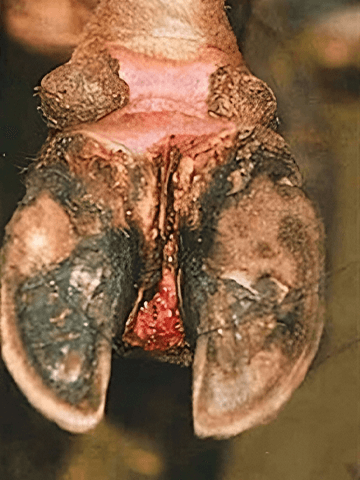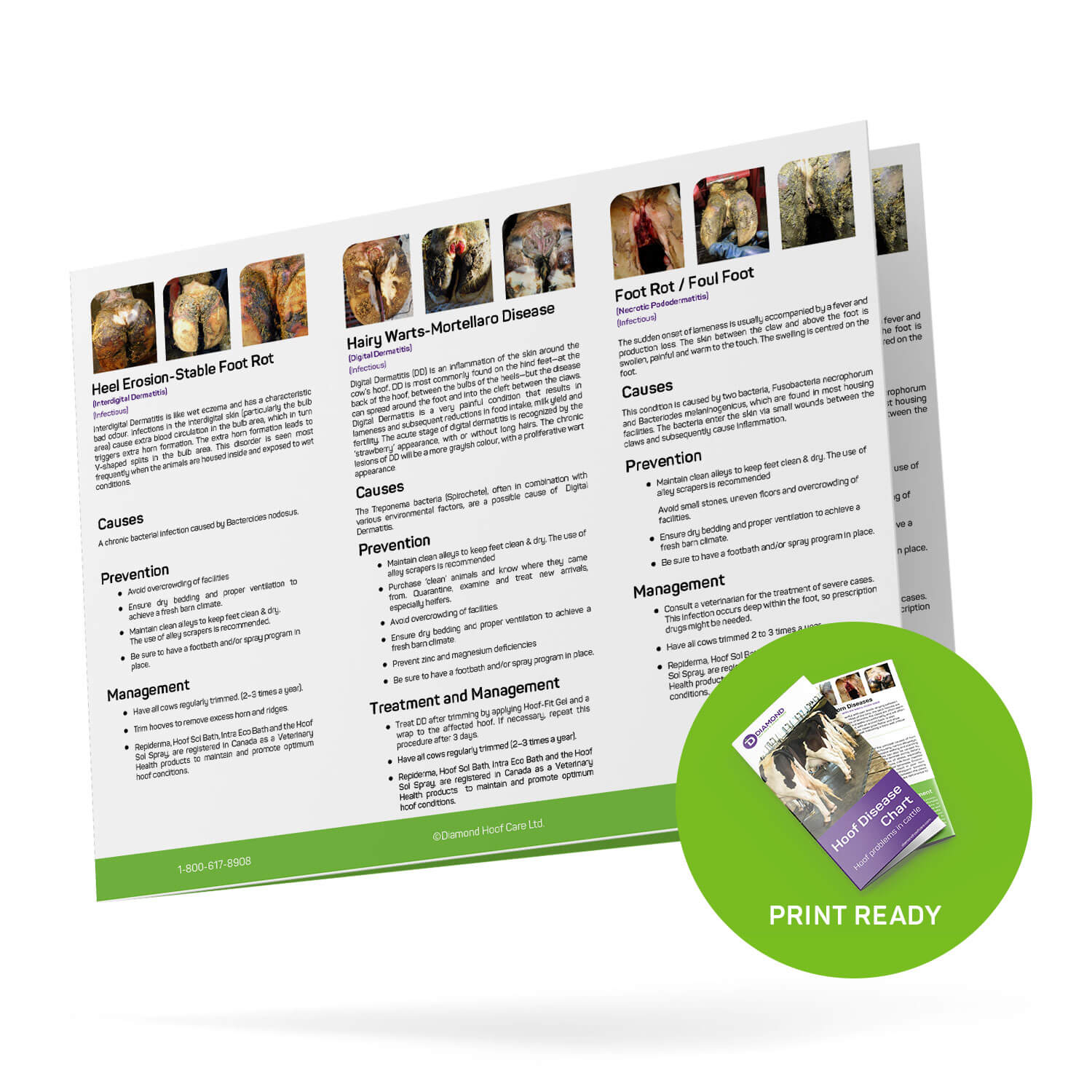About
What is footrot in cows?
Footrot is a highly infectious disease that can affect the productivity and profitability of a cattle herd. This bacterial infection is caused by the Fusobacterium necrophorum and Dichelobacter nodosus bacteria, which invade the soft tissues of the foot, causing inflammation and pain.
Footrot is commonly observed in humid and wet environments, for example, dairy barns, but is also found in rough areas where sharp objects, like stubble, can damage the interdigital skin.
This hoof disease can lead to decreased weight gain, lower milk production, and even permanent lameness in severe cases. Early detection and prompt treatment are critical to reducing the impact of footrot on the animal. Preventive measures such as regular hoof trimming, optimum foot bath protocols, and providing a dry and clean environment can help reduce the risk of infection.
Footrot can be mistaken for other hoof diseases, so careful examination and testing are necessary for an accurate diagnosis. In my post How Does Foot Rot (or Hoof Rot) Affect a Cow’s Performance, I go into detail regarding the difference between Digital Dermatitis and Footrot.



What is the location on the hoof where we find footrot?
What causes footrot in cattle?
How to avoid misdiagnosing footrot
Footrot can be misdiagnosed as other hoof diseases like digital dermatitis or heel erosion.
It’s crucial to differentiate footrot from other hoof diseases with similar symptoms. I have designed a simple Hoof Disease Chart that displays all the different hoof diseases.
To avoid misdiagnosis, it is essential to carefully examine the hoof and look for signs of infection, such as swelling, discharge, and foul odour. Misdiagnosing footrot is a common problem that can lead to ineffective treatment and the potential spread of the disease within a dairy herd.
The sentence I use on my client’s herds is this: The lameness and swelling caused by Footrot has a rapid onset and is centred above the claws. What I mean is this: the animal walked well this morning and is severely lame tonight – that quick. If the swelling is off-centred above one side of the hoof, it is most likely not foot rot but one of the other hoof diseases.
Consulting with a veterinarian can also help ensure the proper treatment and minimize the spread of the disease, improving your cattle’s overall health and productivity.

Hoof Disease Reference Chart
How can we prevent footrot?
Preventing footrot in cattle involves several management practices, for example:
1. Regular hoof trimming: This can help maintain proper hoof shape and prevent the accumulation of dirt and manure in the hoof. Hoof trimming also prevents other hoof problems from developing, which could be misdiagnosed as footrot.
2. Footbaths: Footbaths with the correct protocol can help prevent bacterial infections in the hoof. Our Hoof Sol Bath has been an excellent product for optimum hoof health and healthy skin.
3. Dry environments: Providing a dry and clean environment can help reduce the risk of bacterial infections.
4. Proper nutrition: A balanced diet can help maintain a healthy immune system and reduce the risk of infection.
5. Isolation and treatment of affected animals: Isolating and treating infected animals can help prevent the spread of the disease to other animals.
How can we treat footrot?
As a hoof trimmer, we are very limited in treating footrot, but prompt and proper treatment is essential to control footrot in cattle.
Treatment may involve:
1. Antibiotics: Antibiotics can be used to kill the bacteria causing the infection. Your veterinarian will prescribe the proper intramuscular antibiotic. Time is of the essence and closely related to the success rate.
2. Foot trimming: Trimming the affected hoof can help remove infected tissue and promote healing. A balanced claw gives the animal just better footage.
3. Pain management: Pain medication can help relieve the pain and discomfort associated with footrot. Your veterinarian can help you with the right approach for this.
4. Isolation: Infected animals should be isolated to prevent the spread of the disease to other animals. The affected animal should be close to feed and water. These animals go downhill very fast if these basics are not provided.
5. Wrapping of footrot cows: These animals should not be wrapped to treat footrot. The problem is that any infection fluid can not drain, and the infection goes higher into the leg. In cases with mild footrot and possible digital dermatitis (DD), I have used Intra Hoof-fit Gel to wrap the affected area, but I always remove the wrap within 16-24 hours in cases of footrot.
In conclusion, footrot is a common disease in cattle that can be challenging to manage. Preventing footrot through good management practices is essential, and prompt treatment of infected animals can help reduce the impact of the disease on the herd.